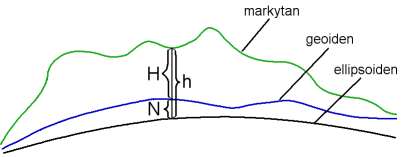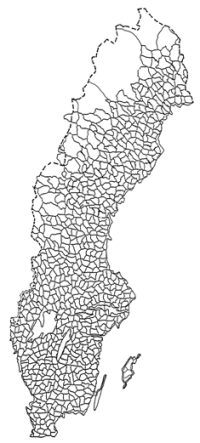Contents of this page may be automatically translated, we take no responsibility for the accuracy of the translation. Feel free to contact our customer support centre if you have any questions.

The Swedish national height system 2000, RH 2000, is the official national height system that was formally adopted in 2005. It is based on the third precise levelling of Sweden, which was carried out during the period 1979–2003
The use of RH 2000
The introduction of RH 2000 has, for the first time, made it possible for all users to connect their local levelling networks to a national height system that both regionally and locally is of very high quality. Today most of the municipalities have connected their local height control networks to the national height reference network and done their transition from old (local) height systems to RH 2000.
Benchmark descriptions with heights in RH 2000 can be ordered from Lantmäteriet's Geodetic Archive.
There is a height correction model (N) for RH 2000 called SWEN17_RH2000, which can be used to convert ellipsoidal heights (h) (GNSS heights) to heights above sea level (H).

The figure illustrates the relationship between different types of heights.
The third precise levelling

The network comprises approximately 50 000 benchmarks and thus has a much wider national coverage than the two previous height systems RH 00 and RH 70. The observations are of much higher quality than those from the two previous precise levelling campaigns.
The vertical datum (zero point) for RH 2000, as well as RH 70, is the Normaal Amsterdams Peil (NAP), which is a point in Amsterdam that is used as the vertical datum in large parts of Western Europe. The RH 2000 network is connected to Sweden's neighbouring countries and has been computed in accordance with European standards, which makes RH 2000 part of the European height system.
As the land surface continuously moves and is deformed vertically due to postglacial land uplift, all heights must be related to a certain time – epoch. The epoch for RH 2000 is the year 2000, which means that the heights of the benchmarks define their vertical positions at that epoch. The magnitude of the land uplift varies between different parts of Sweden: The difference between RH 00 (year 1900) and RH 2000 is approximately one metre where the magnitude of land uplift is greatest around Umeå (in northern Sweden) and close to zero in southern Sweden. The corresponding differences between RH 70 (year 1970) and RH 2000 are about a third of those values.
The third national levelling project and RH 2000 are described in LMV-rapport 2007:14 (pdf, in Swedish, new window).
System facts
- Vertical datum point: Normaal Amsterdam Peil (NAP)
- Reference epoch: Year 2000
- Type of heights: Normal heights
- Standard error: 1.0 mm/√km
- Corrections: Postglacial land uplift, permanent tide (zero), earth curvature, gravity, length of levelling staff etc.

